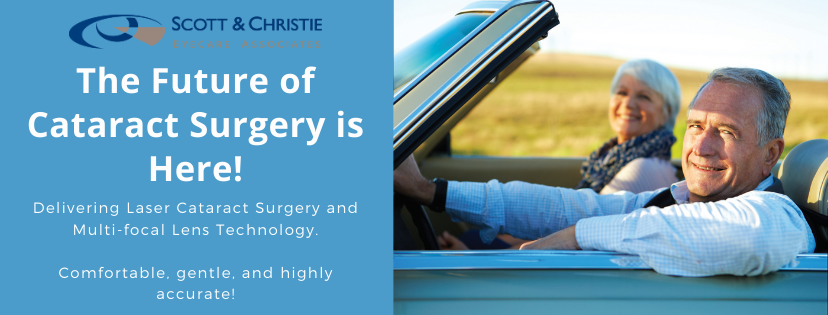
Glaucoma
People who have glaucoma often rely on a traditional eye drop regimen for treatment. Although drops can be effective, many patients may have difficulty putting the drops in effectively and remembering to do them as frequently as prescribed. Also, many prescriptions come with monthly co-payments for refills which can be quite expensive.
There are two alternatives that may allow some patients to eliminate or decrease their dependency on drops – Selective Laser Trabeculoplasty (SLT) and a newly launched pharmaceutical product, Durysta. SLT is a painless laser treatment that is indicated as a primary treatment for glaucoma. It works for an average of five years and can be repeated if needed. Durysta is a biodegradable implant that provides a sustained release of medication inside the eye. Glaucoma patients should ask their eye doctor for more information.
Cataract
Cataracts are a normal aging process for the natural lens inside the eye. As we age, the lens inside the eye becomes cloudy, which can cause many symptoms including blurred vision, glare and halos, difficulty with night-time driving, and fading or yellowing of colors.
Eventually eyeglasses will no longer effectively increase vision function, and surgery is needed to restore vision. Cataract surgery involves removing the cataract and inserting a replacement lens. Traditional cataract surgery lenses are called monofocal lenses, which provide good distance vision but require eyeglasses for near and sometimes intermediate vision.
However, as a treatment advancement, multifocal lens implants are able to provide good distance and near vision and decrease the dependency on glasses.
Dry Eye
Dry eyes can cause symptoms including burning and stinging, pain, irritation, grittiness, scratchiness, sensitivity to cold air or wind, redness, watering/tearing, and blurred vision. Treatment usually hinges on artificial tear drops, but there are many exciting new treatments available for patients with dry eyes. Punctal plugs can be painlessly inserted during a regular office visit. They are designed to allow a patient’s own tears work more effectively to moisturize the surface of the eye. Another treatment for dry eyes is the use of amniotic membrane grafts. These grafts have anti-inflammatory properties and can be very helpful in the treatment of many different eye diseases, including severe dry eye disease. There are also many new and exciting treatments, including both medications and devices, currently in clinical trials. Ask your eye doctor if you may be a good candidate to be involved in a clinical trial.
Eyeglasses
The amount of digital screentime people experience has greatly increased. Digital screens emit a blue-violet wavelength light that has been shown to be disruptive to sleep cycles, increase eye strain and fatigue, and may have a potentially harmful effect to the retina and macula inside the eye.
Fortunately, eyeglasses can now be made with blue-light blocking technology that can increase eye comfort, improve quality of vision, improve sleep quality, and may offer better protection of the retina.
These are just some of the many new and alternative treatment options available for patients by their ophthalmologist. Ask your eye doctor about new and alternative treatment options that may improve your quality of life, and if they are able to provide the most up to date and advanced treatment options available. To schedule an evaluation, visit www.scottandchristie.com or call (724) 772-5420 Cranberry or (412) 782-0400 Fox Chapel.
